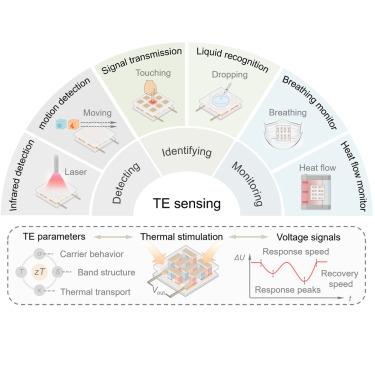扩大热电视野:建立热电参数与多功能传感信号之间的相关性
IF 4.1
2区 综合性期刊
Q1 MULTIDISCIPLINARY SCIENCES
引用次数: 0
摘要
传统上,热电材料一直被用于发电和固态冷却。然而,诸如毒性、有限的转化效率、较差的长期稳定性和高成本等问题继续阻碍着它们的大规模部署。最近,TE材料将热刺激转化为电信号的内在能力越来越受到多功能传感应用的关注,包括触觉反馈、呼吸监测和远程热检测。基于te的传感器具有明显的优势,例如快速响应,高耐用性和出色的信号再现性。从这个角度来看,我们强调了三个战略上重要的研究方向来推进TE传感:(1)研究TE转导过程中的载流子动力学,(2)通过成分和缺陷工程将TE材料性能与关键传感指标相关联,以及(3)将材料设计与机器学习辅助优化相结合。推进这些前沿技术将为物联网、个性化医疗保健和智能工业监控领域的下一代TE传感器奠定基础。本文章由计算机程序翻译,如有差异,请以英文原文为准。

Expanding thermoelectric horizons: Establishing correlations between thermoelectric parameters and multifunctional sensing signals
Thermoelectric (TE) materials have traditionally been explored for power generation and solid-state cooling. However, issues such as toxicity, limited conversion efficiency, poor long-term stability, and high cost continue to hinder their large-scale deployment. Recently, the intrinsic capability of TE materials to convert thermal stimuli into electrical signals has garnered increasing attention for multifunctional sensing applications, including tactile feedback, respiration monitoring, and remote thermal detection. TE-based sensors offer distinct advantages, such as fast response, high durability, and excellent signal reproducibility. In this perspective, we highlight three strategically important research directions to advance TE sensing: (1) investigating carrier dynamics during TE transduction, (2) correlating TE material performance with key sensing metrics via compositional and defect engineering, and (3) integrating materials design with machine learning-assisted optimization. Advancing these frontiers will lay the groundwork for next-generation TE sensors in the Internet of Things, personalized healthcare, and intelligent industrial monitoring.
求助全文
通过发布文献求助,成功后即可免费获取论文全文。
去求助
来源期刊

iScience
Multidisciplinary-Multidisciplinary
CiteScore
7.20
自引率
1.70%
发文量
1972
审稿时长
6 weeks
期刊介绍:
Science has many big remaining questions. To address them, we will need to work collaboratively and across disciplines. The goal of iScience is to help fuel that type of interdisciplinary thinking. iScience is a new open-access journal from Cell Press that provides a platform for original research in the life, physical, and earth sciences. The primary criterion for publication in iScience is a significant contribution to a relevant field combined with robust results and underlying methodology. The advances appearing in iScience include both fundamental and applied investigations across this interdisciplinary range of topic areas. To support transparency in scientific investigation, we are happy to consider replication studies and papers that describe negative results.
We know you want your work to be published quickly and to be widely visible within your community and beyond. With the strong international reputation of Cell Press behind it, publication in iScience will help your work garner the attention and recognition it merits. Like all Cell Press journals, iScience prioritizes rapid publication. Our editorial team pays special attention to high-quality author service and to efficient, clear-cut decisions based on the information available within the manuscript. iScience taps into the expertise across Cell Press journals and selected partners to inform our editorial decisions and help publish your science in a timely and seamless way.
 求助内容:
求助内容: 应助结果提醒方式:
应助结果提醒方式:


